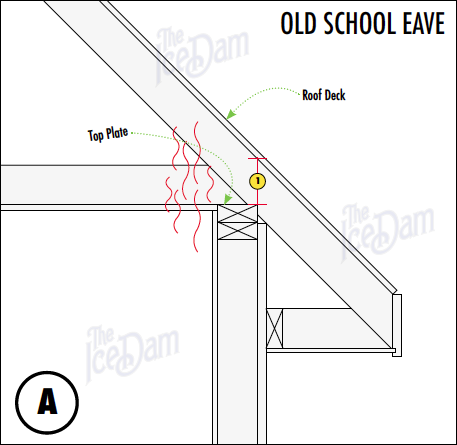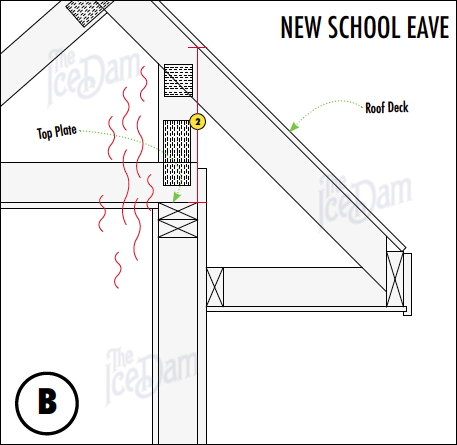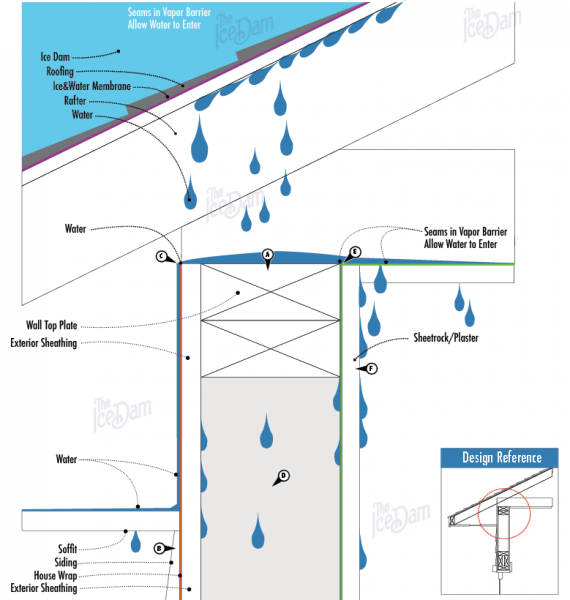Posts Tagged ‘heat tape ice dam prevention’
Tuesday, March 28th, 2017
How Does Eave Style and Construction Method Affect Ice Dam Formation and Severity?
Eave Construction and Heat Transfer
We have discussed the relationship between eave depth and ice dams previously (Case Study #10). Now let’s look into how different construction methodologies affect the likelihood and severity of ice dams in residential and light commercial construction.
For obvious reasons, eaves are a central topic in the world of ice dams. After all, that’s where 98% of ice dams occur, with the other slice of happening in areas including valleys, flat roofs and low pitch roof pans. There is a reason why older homes are affected more by ice dams then newer homes. That relates primarily to the nature of how the eaves are assembled.
Our grandparents didn’t understand the importance of insulation and ventilation as it relates to the eave. (They were busy thinking about wars and famine). In short, there needs to be enough room between the top plate of the wall and the underside of the roof decking to allow for adequate insulation and ventilation. We know that ice dams are created in large part by the escape of heat from the interior, conditioned spaces of a home into areas where that heat is not supposed to be. Namely, it is not supposed to be in the roof cavity next to the roof deck. Homes with less insulation near the eaves are troubled with ice dams far more than those with adequate insulation and ventilation. In Diagram B, we see an example of common eave construction in modern homes. Notice that the distance between the top plate and the roof deck is quite generous. This is commonly referred to as the heel height. In Diagram A, which shows a hand-framed eave, there is virtually no space for insulation or ventilation. Consequently, heat can easily pass from the room below to the roof system, melting the snow above.


Don’t despair if you have old school eaves. There are options to help prevent or at least minimize the likelihood of ice dam problems in the future. Those can be broken down into two broad categories; Architectural and non-Architectural Solutions. In short, Architectural solutions involve modifications to the thermal performance of the home, including insulation, ventilation and, most importantly, sealing air-leaks into the attic or roof truss cavities. The most effective Non-Architectural solution is simple, cheap and effective. Install a high-quality, self-regulating heat tape system on affected areas.
Ask any experienced residential designer, classic architectural styles are difficult to execute with adequate heel heights. Talented designers can pull it off, but they need to think outside the box. High-end, architecturally refined homes don’t look right with clunky, new construction eaves.
To read more Case Studies click here.
Tags: about ice dams, best ice dam removal in minneapolis, best rated ice dam removal contractor, eave style and ice dam formation, eave style and ice dams, edina ice dam removal, heat tape and ice dams, heat tape ice dam prevention, highest rated ice dam removal company in minneapolis, ice and snow removal, ice dam expert, ice dam removal jerks, ice removal company, minneapolis ice dam removal, roof ice steaming, twin cities ice dam remover
Posted in Ice Dam Heat Tape, Ice Dam Prevention, Ice Dam Removal, Ice Dams, Misc., Ice Dams: General Info, Water Damage | Comments Off on Eave Construction and Ice Dams
Tuesday, February 7th, 2017
How to Prevent Ice Dams on Your Home – Answers from the Experts
Overview
To be frank, the entire concept of ice dam prevention is a little bit disingenuous. There are certain circumstances where even the most well constructed, well insulated and ventilated roof system will get ice dams. Those situations are rare, but they do occur. When we talk about ‘prevention’, what we are realistically discussing is the field of work aimed at either reducing the likelihood of ice dams or minimizing the impact of ice dams if they do occur.
Two Approaches to Ice Dam Prevention:
We break ice dam prevention into two broad categories; Architectural and Non-Architectural. Architectural solutions involve modifications to the existing structure to alter the problematic thermal characteristics that are contributing causes of ice dams. In contrast, Non-Architectural solutions are comprised of the work done to minimize the impact of unwanted roof and gutter ice accumulations when they are likely to begin.
Architectural Approach
It’s seldom the case that a single home medication, once implemented, will permanently fix an ice dam problem. More often than not ice dam prevention involves a combination of changes in order to have a significant impact.
A very standard ice dam prevention project for The Ice Dam Company might involve enhancing or replacing the insulation in the attic or roof system, adding ventilation and sealing all of the air-leaks between the heated spaces and the attic and roof framing. Usually, this combination of endeavors yields good results. Sometimes it is necessary to alter the roofing system itself. Normally, this means installing a single ply roof system such as hand-soldered copper pans or a rubber membrane. Single ply roof systems are quite resilient in the face of ice dams but they will to work in all areas due to aesthetics. We will dig further into each of the three basic architectural solutions in other Case Studies.
Certain ice dam creation factors cannot be addressed through Architectural solutions such as insulation, ventilation, air-sealing or roof system enhancements. Case Study #19 discusses the relationship between the sun and ice dams. We recently installed heat tape on a 6 year old, $3.8 million dollar home. The homeowner had spared no expense relative to energy efficiency in the original design and construction. That was not the issue. The problem was simply that the sun was melting the snow on an exposed roof plane higher on the home which resulted in melt water running down to a cold eave area that was hidden from the sun. There it would re-freeze in cycles to create an ice dam that kept coming back year after year.
Non-Architectural Approach
In terms of ice dam prevention, there is a small set of options available that fall outside of the Architectural solutions. These involve systems to manage snow and ice accumulations as they develop on a roof. The most popular Non-Architectural ice dam solution is heat cables. Otherwise known as heat tape and roof deicing, heat cables are wires that warm up in response to electrical current. Typically, heat cables are installed in a serpentine or zig-zag pattern on a roof along the eaves. To be clear, heat cables do not resolve the underlying issues related to why ice dams are happening rather they help manage the issue of unwanted ice accumulations when the conditions are ripe for their formation. A common complaint about heat tape is that it does not address the real issues causing the ice dams. This complaint is justified because it is true. That said, heat cable systems can be installed on a home for a fraction of the cost of traditional Architectural solutions. Many homeowners are not in the position to spend $5,000 to $25,000 for Architectural ice dam solutions making the idea of a $1,000 heat cable system very appealing. We do both approaches every day.
We would be remiss in not mentioning the very most basic thing you can do to minimize the likelihood of ice dams; Roof shoveling. Diligently removing the snow from your roof can greatly reduce the likelihood of ice dams. Unfortunately, some roofs are too high or have areas inaccessible to the average homeowner, making roof snow removal an ineffective approach to guaranteed ice dam prevention. Removing all of the snow from the roof planes affected by the ice dams is very important. See the Ice Dam Company Case Study #3 that discusses a phenomenon called the ‘Double Dam’.
To read more Case Studies click here.
Tags: about ice dams, best ice dam removal in minneapolis, best rated ice dam removal contractor, commercial ice removal, edina ice dam removal, heat tape and ice dams, heat tape ice dam prevention, highest rated ice dam removal company in minneapolis, ice removal company, minneapolis ice dam removal, orono ice dam removal, preventing ice dams, twin cities ice dam remover, wayzata ice dam removal
Posted in Ice Dam Heat Tape, Ice Dam Prevention, Ice Dam Removal, Ice Dams, Misc., Ice Dams: General Info | Comments Off on Ice Dam Prevention: Two Approaches
Thursday, December 15th, 2016
A Simple Explanation of Where the Water Goes When Ice Dams Cause Leaks
Where the Water Travels:
Water hitting the Top Plate of the wall (A) spreads out across the top plate, travels downward with gravity, working behind the Siding (B) the Housewrap (C), the Insulation (D), the Vapor Barrier (E) and the Drywall (F). Water always seeks the path of least resistance and therefore frequently shows up through existing penetrations in the ceiling such as lights. Water leaks caused by ice dams can travel many feet from the source before manifesting inside the home. On homes built with vapor barriers on top of the ceiling finish, water will sit on top of the drywall and soak the insulation before leaking inside.

To read more Case Studies click here.
Tags: about ice dams, best ice dam removal in minneapolis, best rated ice dam removal contractor, edina ice dam removal, edina ice dam steaming, heat tape, heat tape ice dam, heat tape ice dam prevention, highest rated ice dam removal company in minneapolis, how do I know I have ice dams, how to tell if an ice dam is a problem, ice and snow removal, ice dam heat cable, orono ice dam removal, twin cities ice dam remover, wayzata ice dam removal
Posted in Ice Dams, Misc., Ice Dams: General Info | Comments Off on Close Up of an Ice Dam Leak








